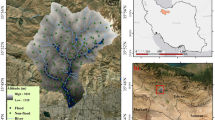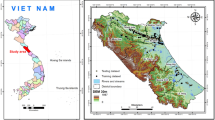Abstract
The Evaluation of flood risk is a difficult task due to its numerous and complex impact factors. This article built a classification and regression tree (CART) model for the flood risk assessment with the available data of Hunan Province. This model is able to extract the major impact factors from many complex variables, determine the factors’ thresholds, and evaluate the levels of flood risk objectively. To construct the model, 18 explanatory variables were selected as the influential factors, including meteorological conditions, surface conditions and social vulnerability. Economic loss density from flood was chosen as the response variable for the quantitative and comprehensive evaluation of flood risk. The final model showed that meteorological conditions have the most significant influence on flood risk. Additionally, the relationship between meteorological factors and flood risk is rather complex. The variability of rainstorm days during the seasonal alternate period from the end of spring (May) to the early summer (June) is the source of the highest flood risk. In addition, the regional embankment density and population density as social vulnerability indicators and the relief degree of land surface as a surface condition indicator were also included in the flood risk assessment for Hunan. A region with dense dams appeared at a relatively higher risk. Densely inhabited areas with greater topographical relief also demonstrated a higher flood risk in the study area. The conditions obtained from the final tree for different levels of risk demonstrate the objectivity of selecting impact factors and a reduction of complexity for the risk evaluation process. Furthermore, the evaluation of high-level risk using the proposed method requires fewer conditions, which allows for a rapid risk assessment of serious floods. The CART method shows a decreased root mean squared error compared with that of a multiple linear regression model. In addition, the cross-validation error was improved for the high-risk levels that represent the most important classes in risk management. The verification with the available historical records showed that the output of the model is reliable. In summary, the CART method is feasible for extracting the main impact factors and their associated thresholds for the comprehensive assessment of regional flood risk.








Similar content being viewed by others
References
Alkema D (2003) Flood risk assessment for EIA; an example of a motorway near Trento, Italy. Stud Trent Sci Nat Acta Geol 78:147–153
Apel H, Thieken AH, Merz B, Bloschl G (2006) A probabilistic modelling system for assessing flood risks. Nat Hazards 38:79–100
Arlot S (2010) A survey of cross-validation procedures for model selection. Stat Surv 4:40–90
Atmospheric Science Dictionary Editorial Board (2006) China’s meteorological disaster dictionary, volume of Hunan. China Meteorological Press, Beijing (in Chinese)
Bakeev KA (2010) Process analytical technology: spectroscopic tools and implementation strategies for the chemical and pharmaceutical industries. CPI Antony Rowe, Chippenham
Barthès B, Roose E (2002) Aggregate stability as an indicator of soil susceptibility to runoff and erosion; validation at several levels. Catena 47:133–149
Bouman BAM, Humphreys E, Tuong TP, Barker R (2007) Rice and water. Adv Agron 92:187–237
Breiman L, Friedman JH, Olshen RA, Stone CJ (1984) Classification and regression trees. The Wadsworth statistics/probability series. Chapman and Hall, New York
Camarasa AM, López-García MJ, Soriano-García J (2011) Mapping temporally-variable exposure to flooding in small Mediterranean basins using land-use indicators. Appl Geogr 31:136–145
Cutter SL, Finch C (2008) Temporal and spatial changes in social vulnerability to natural hazards. PNAS 105:2301–2306
Cutter SL, Boruff BJ, Shirley WL (2003) Social vulnerability to environmental hazards. Soc Sci Q 84:242–261
Dawson R, Hall J, Sayers P, Bates P, Rosu C (2005) Sampling-based flood risk analysis for fluvial dike systems. Stoch Environ Res Risk Assess 19:388–402
de Moel H, Aerts JCJH, Koomenb E (2010) Development of flood exposure in the Netherlands during the 20th and 21st century. Glob Environ Change 21:620–627
Deconinck E, Hancock T, Coomans D, Massart DL, Heyden YV (2005) Classification of drugs in absorption classes using the classification and regression trees (CART) methodology. J Pharm Biomed 39:91–103
Erpicum S, Dewals B, Archambeau P, Detrembleur S, Pirotton M (2010) Detailed inundation modelling using high resolution DEMs. Eng Appl Comput Fluid Mech 4:196–208
Federal Emergency Management Agency (FEMA) (2003) Hazus-MH MR5 multi-hazard loss estimation model methodology—flood model, user manual. Department of Homeland, FEMA, Washington, DC
Feng ZM, Tang Y, Yang YZ, Zhang D (2008) Relief degree of land surface and its influence on population distribution in China. J Geogr Sci 18:237–246
Gilard O, Givone P (1997) Flood risk management: new concepts and methods for objective negotiations. In: Proceedings of the destructive water: water-caused natural disasters, their abatement and control, IAHS Pulb 239, IAHS Press, Wallingford, pp 145–155
Hastie T, Tibshirani R, Friedman J (2008) The elements of statistical learning: data mining, inference, and prediction. Springer Series in Statistics. Springer, Stanford, pp 305–308
Horritt MS, Bates PD (2002) Evaluation of 1D and 2D numerical models for predicting river flood inundation. J Hydrol 268:87–99
Huang YM, Zhang XP, Liu F, Zhang JM, Huang YB (2007) Precipitation change in Hunan and its relationship to that in India. Trop Geogr 27(5):416–419
Huang X, Tan HZ, Zhou J, Yang TB, Benjamin A, Wen SW, Li SQ, Liu AZ, Li XH, Fen SD, Li XL (2008) Flood hazard in Hunan province of China: an economic loss analysis. Nat Hazards 47:65–73
Hunan Bureau of Statistics (2012) 2011 Hunan statistical yearbook. China Statistics Press, Beijing
Ian CF (2008) Geomorphic impacts of a 100-year flood: Kiwitea Stream, Manawatu catchment, New Zealand. Geomorphology 98:84–95
Ito A, Hayashi M, Hamasaki T, Ebisu S (2011) Risk assessment of dental caries by using classification and regression trees. J Dent 39:457–463
Jenks GF (1967) The data model concept in statistical mapping. Int Yearb Cartogr 7:186–190
Jonkman SN, Kok M, Vrijling JK (2008) Flood risk assessment in the Netherlands: a case study for dike ring South Holland. Risk Anal 28:1357–1373
Kandilioti G, Makropoulos C (2012) Preliminary flood risk assessment: the case of Athens. Nat Hazards 61:441–468
Kim ES, Choi H (2011) Assessment of vulnerability to extreme flash floods in design storms. Int J Environ 8:2907–2922
Knotters M, BRUS DJ, Voshaar JHO (1995) A comparison of Kring, Co-Kring and Kring combined with regression for spatial interpolation of horizon depth with censored observations. Geoderma 67:227–246
Kohavi R (1995) A study of cross-validation and bootstrap for accuracy estimation and model selection. In: Proceedings of the fourteenth international joint conference on artificial intelligence, vol 12, Montreal, pp 1137–1143
Leinster P (2009) Flooding in England: a national assessment of flood risk. Environment Agency, Almondsbury
Li K, Li GS (2011) Vulnerability assessment of storm surges in the coastal area of Guangdong Province. Nat Hazards Earth Syst Sci 11:2003–2010
Li LF, Wang JF, Leung H, Jiang CS (2010) Assessment of catastrophic risk using Bayesian network constructed from domain knowledge and spatial data. Risk Anal 30:1157–1175
Livingstone DJ, Salt DW (2005) Judging the significance of multiple linear regression models. J Med Chem 48:661–663
McCarthy JJ, Canziani OF, Leary NA, Dokken DJ, White KS (2001) Climate change 2001: impacts, adaptation and vulnerability. Cambridge University Press, Cambridge
Mendes BVD, Pericchi LR (2009) Assessing conditional extremal risk of flooding in Puerto Rico. Stoch Environ Res Risk Assess 23:399–410
Meyer V, Scheuer S, Haase D (2009) A multicriteria approach for flood risk mapping exemplified at the Mulde river, Germany. Nat Hazards 48:17–39
Miao HJ (1988) Land and water resources in the Pearl River Delta. Sun Yat-sen University Press, Guangzhou (in Chinese)
Nirel R, Dayan U (2001) On the ratio of sulfur dioxide to nitrogen oxides as an indicator of air pollution sources. J Appl Meteorol 40:1209–1222
Okazawa Y, Yeh PJF, Kanae S, Oki T (2011) Development of a global flood risk index based on natural and socio-economic factors. Hydrol Sci J 56:789–804
Parry ML, Canziani OF, Palutikof JP, van der Linden PJ, Hanson CE (2007) IPCC fourth assessment report: climate change 2007 (AR4): working Group II report, impacts, adaptation and vulnerability. Cambridge University Press, Cambridge
Put R, Perrin C, Questier F, Coomans D, Massart DL, Heyden YV (2003) Classification and regression tree analysis for molecular descriptor selection and retention prediction in chromatographic quantitative structure-retention relationship studies. J Chromatogr A 988:261–276
Rovlias A, Kotsou S (2004) Classification and regression tree for prediction of outcome after severe head injury using simple clinical and laboratory variables. J Neurotraum 21:886–893
Schmidtlein MC, Deutsch RC, Piegorsch WW, Cutter SL (2008) A sensitivity analysis of the social vulnerability index. Risk Anal 28:1099–1114
Seifert I, Thieken AH, Merz M, Borst D, Werner U (2010) Estimation of industrial and commercial asset values for hazard risk assessment. Nat Hazards 52:453–479
Tachiiri K, Shinoda M (2011) Quantitative risk assessment for future meteorological disasters reduced livestock mortality in Mongolia. Clim Change 113(3−4):867−882
Tachiiri K, Shinoda M, Klinkenberg B, Morinaga Y (2008) Assessing Mongolian snow disaster risk using livestock and satellite data. J Arid Environ 72:2251–2263
Takar AA, Dobrowolski JP, Thurow TL (1990) Influence of grazing, vegetation life-form, and soil type on infiltration rates and interrill erosion on a Somalion rangeland. J Range Manage 43:486–490
Thieken AH, Müller M, Kleist L, Seifert I, Borst D, Werner U (2006) Regionalisation of asset values for risk analyses. Nat Hazards Earth Syst Sci 6:167–178
Thuring F, Gustafsson J (2008) A suitable parametric model for operational risk applications. Working paper, SSRN
Unami K, Abagale FK, Yangyuoru M, Alam AMB, Kranjac-Berisavljevic G (2010) A stochastic differential equation model for assessing drought and flood risks. Stoch Environ Res Risk Assess 24:725–733
Vandeginste BGM, Massart DL, Buydens LMC, Jong SD, Lewi PJ, Smeyers-Verbeke J (1997) Handbook of chemometrics and qualimetrics—Part B. Elsevier, Amsterdam
Vayssiéres MP, Plant RE, Allen-Diaz BH (2000) Classification trees: an alternative non-parametric approach for predicting species distributions. J Veg Sci 11:679–694
Venables WN, Ripley BD (2002) Tree based methods. In: modern applied statistics with S, 4th edn. Springer, New York, pp 251–270
Vorogushyn S, Merz B, Lindenschmidt KE, Apel H (2010) A new methodology for flood hazard assessment considering dike breaches. Water Resour Res 46:1–17
Wang YM, Li ZW, Tang ZH, Zeng GM (2011) A GIS-based spatial multi-criteria approach for flood risk assessment in the Dongting Lake region, Hunan, Central China. Water Resour Manag 25:3465–3484
Wheater HS, Chandler RE, Onof CJ, Isham VS, Bellone E, Yang C, Lekkas D, Lourmas G, Segond ML (2005) Spatial–temporal rainfall modelling for flood risk estimation. Stoch Environ Res Risk Assess 19:403–416
Xia JQ, Falconer RA, Lin BL, Tan GM (2011) Numerical assessment of flood hazard risk to people and vehicles in flash floods. Environ Model Softw 26:987–998
Xu YP, Booij MJ, Tong YB (2010) Uncertainty analysis in statistical modeling of extreme hydrological events. Stoch Environ Res Risk Assess 24:567–578
Zahran S, Brody SD, Peacock WG, Vedlitz A, Grover H (2008) Social vulnerability and the natural and built environment: a model of flood casualties in Texas. Disasters 32:537–560
Zhou Q, Mikkelsen PS, Halsnæs K, Arnbjerg-Nielsen K (2012) Framework for economic pluvial flood risk assessment considering climate change effects and adaptation benefits. J Hydrol 414:539–549
Acknowledgments
This work was supported by the National Basic Research Program of China (973) (2012CB955402), the National Natural Science Foundation of China (41101506, 41171401), and the International Cooperation Project funded by Ministry of Science and Technology of China (S2012GR0231).
Author information
Authors and Affiliations
Corresponding author
Rights and permissions
About this article
Cite this article
Ji, Z., Li, N., Xie, W. et al. Comprehensive assessment of flood risk using the classification and regression tree method. Stoch Environ Res Risk Assess 27, 1815–1828 (2013). https://doi.org/10.1007/s00477-013-0716-z
Published:
Issue Date:
DOI: https://doi.org/10.1007/s00477-013-0716-z




